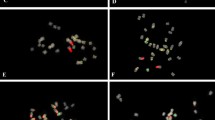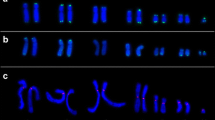Abstract
Sorex araneus and Sorex granarius are sibling species within the Sorex araneus group with karyotypes composed of almost identical chromosome arms. S. granarius has a largely acrocentric karyotype, while, in S. araneus, various of these acrocentrics have combined together by Robertsonian (Rb) fusions to form metacentrics, with the numbers and types of metacentrics differing between chromosomal races. Our studies on telomeric sequences in S. araneus and S. granarius revealed differences between chromosomes and between species. In S. araneus (the Novosibirsk race), hybridization signals were present on the telomeres of all the chromosomes after FISH with a PCR-generated telomeric probe. In addition, hybridization signals were observed at high frequencies in the pericentric regions of some but not all metacentrics formed by Rb fusion. There were fewer signals on those metacentrics formed earlier in the evolution of S. araneus. This suggests that S. araneus chromosomes retain at least some telomeric repeats during Rb fusion, but that these repeats are lost or modified over time. These results are critical for the interpretation of the well-studied hybrid zones between chromosomal races of S. araneus, given that Rb fission has been postulated in such hybrid zones and that the likelihood of Rb fission will relate to presence/absence of telomeric sequences at the centromeres of metacentrics. In S. granarius, there were strong signals at the proximal (centromeric) telomeres of the acrocentrics after FISH with a DNA telomeric probe. FISH with a PNA telomeric probe on S. granarius acrocentrics showed that the proximal telomeres were 213 kb on average, while the length of the distal telomeres was 3.8 kb on average. Two-colour FISH, using a telomeric DNA probe and a microdissected probe generated from the pericentric regions of the S. granarius chromosomes a and b, revealed regions on distinct chromatin fibres where telomeric and microdissected probes were colocalized or localized sequentially. The proximal telomeres of S. granarius are highly unusual both in their large size and their heterogeneous structure relative to the telomeres of other mammals.
Similar content being viewed by others
References
Azzalin CM, Nergadze SG, Giolotto E (2001) Human intrachromosomal telomeric-like repeats: sequence organization and mechanism of origin. Chromosoma 110: 75–82.
Brünner H, Lugon-Moulin N, Balloux F, Fumagalli L, Hausser J (2002) A taxonomical re-evaluation of the Valais chromosome race of the common shrew Sorex araneus (Insectivora: Soricidae). Acta Theriol 47: 245–275.
Castiglia R, Gornung E, Corti M (2002) Cytogenetic analyses of chromosomal rearrangements in Mus minutoides/musculoides from North–West Zambia through mapping of the telomeric sequence (TTAGGG)n and banding techniques. Chromosome Res 10: 399–406.
Dobigny G, Ozouf-Costaz C, Bonillo C, Volobouev V (2003) Evolution of rRNA gene clusters and telomeric repeats during explosive genome repatterning in Taterillus X (Rodentia, Gerbillinae). Cytogenet Genome Res 103: 94–103.
Garagna S, Broccoli D, Redi CA, Searle JB, Cook HJ, Capanna E (1995) Robertsonian metacentrics of the house mouse lose telomeric sequences but retain some minor satellite DNA in the pericentromeric area. Chromosoma 103: 685–692.
Garagna S, Zuccotti M, Capanna E, Redi CA (2002) High-resolution organization of mouse telomeric and pericentromeric DNA. Cytogenet Genome Res 96: 125–129.
Hanish JP, Yanowitz JL, de Lange T (1994) Stringent sequence requirements for the formation of human telomeres. Proc Natl Acad Sci USA 91: 8861–8865.
Hartmann N, Scherthan H (2004) Characterization of ancestral chromosome fusion points in the Indian muntjac deer. Chromosoma 112: 213–220.
Hausser J, Fumagalli L, Taberlet P (1998) Mitochondrial DNA evolution in shrews. In Wójcik JM, Wolsan M Eds. Evolution of Shrews. Białowieża, Poland: Mammal Research Institute, pp 295–308.
Ijdo JW, Wells RA, Baldini A, Reeders ST (1991) Improved telomere detection using a telomere repeat probe (TTAGGG)n generated by PCR. Nucleic Acids Res 19: 4780.
Kilburn AE, Shea MJ, Sargent RG, Wilson JH (2001) Insertion of a telomere repeat sequence into a mammalian gene causes chromosome instability. Mol Cell Biol 21: 126–135.
Lansdorp PM, Verwoerd NP, van de Rijke FM et al. (1996) Heterogeneity in telomere length of human chromosomes. Hum Mol Genet 5: 685–691.
Manning EL, Crosland J, Dewey MJ, Van Zant G (2002) Influence of inbreeding and genetics on telomere length in mice. Mamm Genome 13: 234–238.
Martens UM, Zijlmans JM, Poon SS et al. (1998) Short telomeres on human chromosome 17p. Nat Genet 18: 76–80.
Metcalfe CJ, Eldridge MD, Toder R, Johnston PG (1998) Mapping of the distribution of the telomeric sequence (TTAGGG)n in the Macropoidea (Marsupialia) by fluorescence in-situ hybridization. 1. The swamp wallaby, Wallabia bicolor. Chromosome Res 6: 603–610.
Meyne J, Baker RJ, Hobart HH et al. (1990) Distribution of non-telomeric sites of the (TTAGGG)n telomeric sequences in vertebrate chromosomes Chromosoma 99: 3–10.
Mondello C, Pirzio L, Azzalin CM, Giulotto E (2000) Instability of interstitial telomeric sequences in the human genome. Genomics 68: 111–117.
Nanda I, Schneider-Rasp S, Winking H, Schmid M (1995) Loss of telomeric sites in the chromosomes of Mus musculus domesticus (Rodentia: Muridae) during Robertsonian rearrangements. Chromosome Res 3: 399–409.
Pack SD, Borodin PM, Serov OL, Searle JB (1993) The X-autosome translocation in the common shrew (Sorex araneus L.): late replication in female somatic cells and pairing in male meiosis. Chromosoma 102: 355–360.
Pagnozzi JM, De Jesus Silva MJ, Yonenaga-Yassuda Y (2000) Intraspecific variation in the distribution of the interstitial telomeric (TTAGGG)n sequences in Micoureus demerarae (Marsupialia: Didelphidae). Chromosome Res 8: 585–591.
Rivero MT, Mosquera A, Goyanes V, Slijepcevic P, Fernandez JL (2004) Differences in repair profiles of interstitial telomeric sites between normal and DNA double-strand break repair deficient Chinese hamster cells. Exp Cell Res 295: 161–172.
Rogatcheva MB, Ono T, Sonta S, Oda S, Borodin PM (2000) Robertsonian metacentrics of the house musk shrew (Suncus murinus. Insectivora. Soricidae) lose the telomeric sequences in the centromeric area. Genes Genet Syst 75: 155–158.
Rubtsov N, Karamysheva T, Babochkina T et al. (2000) A new simple version of chromosome microdissection tested by probe generation for 24-multi-color FISH, Multi-color banding (MCB), ZOO-FISH and in clinical diagnostics. Medgen 12: 65.
Ruiz-Herrera A, Garcia F, Azzalin C, Giulotto E, Ponsa M, Garcia M (2002) Distribution of intrachromosomal telomeric sequences (ITS) on Macaca fascicularis (Primates) chromosomes and their implication for chromosome evolution. Hum Genet 110: 578–586.
Searle JB, (1993) Robertsonian Chromosomal Variation in the Common Shrew Sorex araneus L. PhD thesis, University of Aberdeen.
Searle JB (1993) Chromosomal hybrid zones in eutherian mammals. In: Harrison RG (ed) Hybrid Zones and the Evolutionary Process. New York: Oxford University Press, pp. 309–353.
Searle JB, Fedyk S, Fredga K, Hausser J, Volobouev VT (1991) Nomenclature for the chromosomes of the common shrew (Sorex araneus). Mem Soc Vaud Sc Nat 19: 13–22.
Sharman GB (1991) History of discovery and recognition of XY1Y2 systems and chromosome polymorphism in mammals. Mem Soc Vaud Sc Nat 19: 7–12.
Slijepcevic P (1998) Telomeres and mechanisms of Robertsonian fusion. Chromosoma 107: 136–140.
Volobouev VT, Dutrillaux B (1991) Chromosomal evolution and phylogenetic relationships of the Sorex araneus–arcticus species group. Mem Soc Vaud Sc Nat 19: 131–139.
Wójcik JM, Searle JB (1988) The chromosome complement of Sorex granarius — the ancestral karyotype of the common shrew (Sorex araneus)? Heredity 61: 225–229.
Wójcik JM, Borodin PM, Fedyk S et al. (2003) The list of the chromosome races of the common shrew Sorex araneus (updated 2002). Mammalia 67: 169–178.
Zhu L, Hathcock KS, Hande P, Lansdorp PM, Seldin MF, Hodes RJ (1998) Telomere length regulation in mice is linked to a novel chromosome locus. Proc Natl Acad Sci USA 95: 8648–8653.
Zijlmans JM, Martens UM, Poon SS et al. (1997) Telomeres in the mouse have large inter-chromosomal variations in the number of T2AG3 repeats. Proc Natl Acad Sci USA 94: 7423–7438.
Zima J, Lukáèová L, Macholán M (1998) Chromosomal evolution in shrews. In: Wójcik JM, Wolsan M Eds. Evolution of Shrews. Białowieża, Poland: Mammal Research Institute, pp. 175–218.
Author information
Authors and Affiliations
Corresponding author
Rights and permissions
About this article
Cite this article
Zhdanova, N.S., Karamisheva, T.V., Minina, J. et al. Unusual distribution pattern of telomeric repeats in the shrews Sorex araneus and Sorex granarius. Chromosome Res 13, 617–625 (2005). https://doi.org/10.1007/s10577-005-0988-3
Received:
Accepted:
Published:
Issue Date:
DOI: https://doi.org/10.1007/s10577-005-0988-3




